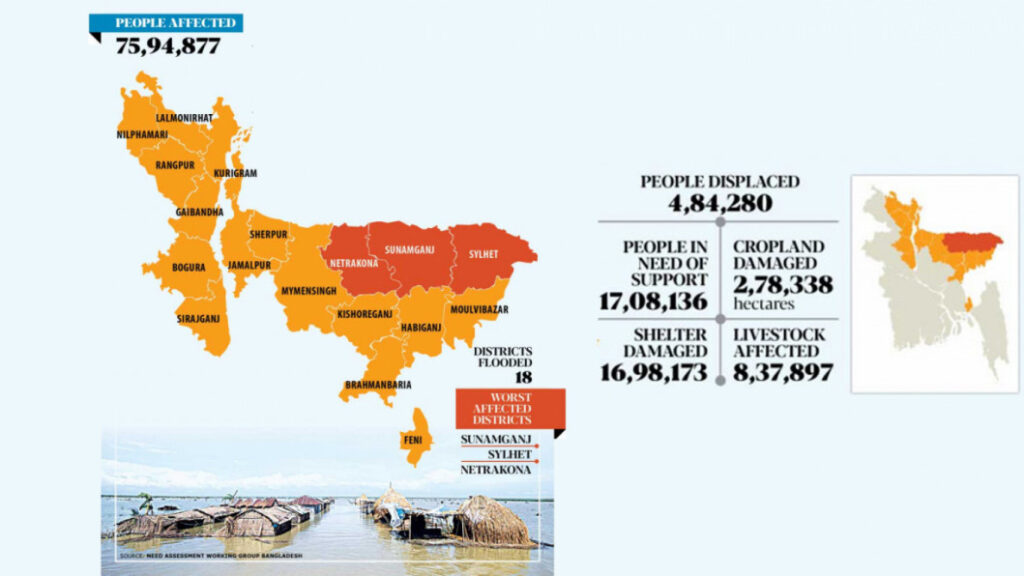The Daily Star
“The water has started receding and we will assess the loss and damage soon, but rehabilitating four lakh people will be a great challenge for us.”
Rehabilitation of around four lakh people, who were worst hit by the floods and lost their homes, is the biggest challenge in the government’s recovery efforts.
Other major challenges include repairing roads and bridges damaged in the floods and stepping up relief efforts, government officials and experts said.
Md Enamur Rahman, state minister for disaster management and relief, told The Daily Star yesterday that in their initial assessment in Sylhet and Sunamganj, they found 21.5 lakh people were affected by the floods that have ravaged the region since mid-June.
“The water has started receding, and we will run a full assessment of damages soon, but rehabilitating the four lakh people will be a great challenge for us,” the state minister said.
Enamur further said the ongoing relief activities will continue till normalcy returns in the region.
According to the UN and government officials, flash floods have affected at least 72 lakh people in nine districts in the north-eastern districts of the country, while nearly five lakh people have faced temporary displacement.
Among the nine-flood hit north-eastern districts, Sylhet, Sunamganj and Netrakona are the worst hit areas where the government is putting special focus, the officials said.
Experts said relief dependency should be reduced as soon as possible, and employment opportunities should be created for flood-hit people as part of their rehabilitation.
“First, the loss and damage assessment should be completed along with finding out the worst affected people,” Professor Mahbuba Nasreen, former director of Institute of Disaster Management and Vulnerability Studies, University of Dhaka, said.
“The government should provide agricultural inputs or other logistics and also create alternative employment for those who need it most. The government should also extend support to the people who need reconstruction of houses.”
The Department of Disaster Management (DDM) said they are hopeful of completing the loss and damage assessments of flood-affected areas of the 17 districts by July 7.
“We are hopeful of getting the information by July 5 and then it may take a day or two to complete the assessment,” said Atiqul Huq, director general of the DDM, adding that short and long-term programmes will be taken after completing the assessment.
He said Sunamganj, Sylhet and Netrakona are the areas worst hit in the recent floods caused by heavy rains in the north-eastern region and upstream Indian states of Assam and Meghalaya, which inundated 72 percent of Sylhet division, including 89 percent of Sunamganj.
Atiqul said the Ministry of Disaster Management and Relief is holding daily meetings with local and international development partners to discuss relief and rehabilitation programmes.
DDM officials said Tk 625 crore in assistance, Tk 4 crore worth of food for children, Tk 4 crore worth of fodder and 1.3 lakh food packets have been distributed among flood victims.
Kaiser Rejve, director of humanitarian and resilience programme of Care Bangladesh, said the government should intensify ongoing relief activities and create employment opportunities for the flood-hit people.
“Both should happen simultaneously and then relief dependency should be reduced gradually,” he suggested.
Meanwhile, the United Nations Resident Coordinator Office’s humanitarian coordination task team in a statement called for funds totalling $58.4 million, or Tk 545 crore, to meet the immediate humanitarian needs, including relief and rehabilitation, for at least 1.5 million out of 7.2 million people affected by flash floods in nine north-eastern districts of the country.
It said food and nutrition assistance is most necessary, with $18.5 million needed to support around half a million people.

